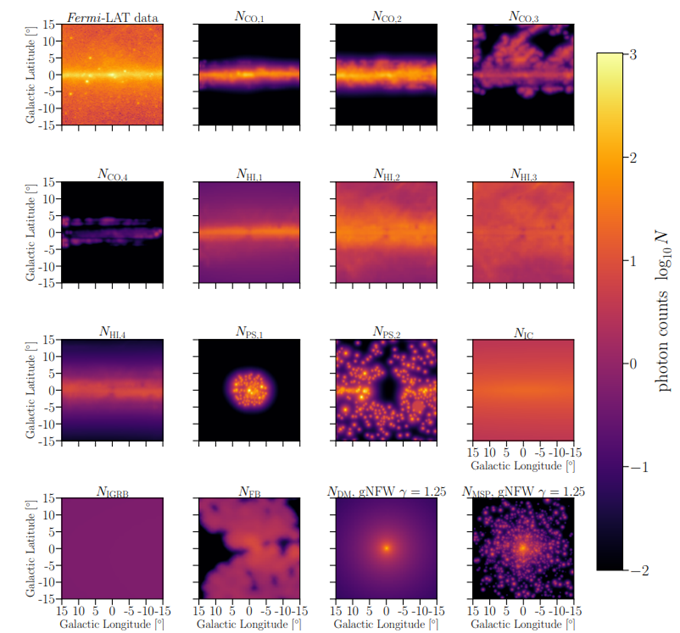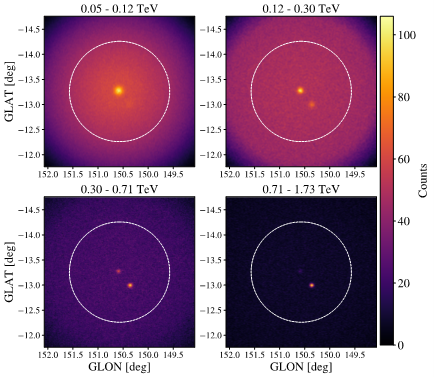Dark Matter Searches
Variety of astrophysical observations suggests that about 85% of the matter in the universe is made up of hypothetical form of matter called Dark Matter. For example, observations of velocities of stars inside of galaxies, suggest that Galaxies are 'heavier’ than what we would estimate, based only of the stars and gas that we know that galaxies have. This, and many other complementary observations, lead scientists to deduce that dark matter is ubiquitous in the universe and to have had a strong influence on its structure and evolution.
Dark matter is called dark because it does not appear to interact with observable electromagnetic radiation, such as light, and is thus invisible to the entire electromagnetic spectrum, making it extremely difficult to detect using usual astronomical equipment. However, even if dark matter particles interact via electroweak interaction with known massive particles, the signals from these interactions could still be indirectly observed. For example, in regions of high dark matter density (e.g., the centre of our galaxy) pairs of dark matter particles could annihilate to produce photons with energies close to the 100 times of a mass of a proton.
Is there dark matter in the center of our galaxy?
The excess of GeV enery range photons from the Galactic Center has been debated for over a decade, with the possibility that it might be due to dark matter annihilation or undetected point sources such as millisecond pulsars (MSPs). A recent study involving our researcher has investigated how the gamma-ray emission model (γEM) used in Galactic center analyses affects the interpretation of the GCE's nature. To address this issue the authors explored the two main competing hypotheses for the GCE using a set of γEMs with increasing parametric freedom. Importantly the researchers conclude that the statement about the nature of the GCE (dark matter or not) strongly depends on the assumed γEM. The researchers used state-of-the-art deep neural network architecture to quantify the reality gap between different γEMs revealing that all employed γEMs have gaps with the reality. This study also casts doubt on the validity of previous conclusions regarding the GCE and dark matter.
Read more here: Mind the gap: the discrepancy between simulation and reality drives interpretations of the Galactic Center Excess [JCAP Link]

Compilation of the spatial morphology of all the gamma-ray templates (ex: CO: Carbon Monoxide, H1: atomic neutral hydrogen, IC: inverse Compton etc.) used in the baseline setup to model γEMs in the galactic center region are shown here. The first panel shows the real Fermi-LAT data with photon energies between 1-2 GeV (same for all other templates). The color intensity indicates the base-10 logarithm of the number of expected γ-ray events for the Fermi-LAT observation time in the infinite statistics limit.
Is there dark matter in other galaxies?
Clusters of galaxies are excellent targets to search for signals of dark matter (DM) annihilation and decay at gamma-ray energies and are predicted to be sources of large-scale gamma-ray emission due to hadronic interactions in the intra-cluster medium. Led by our researcher, in this study, the sensitivity of the CTA Telescope to detect diffuse gamma-ray emission from the Perseus galaxy cluster was estimated. The study highlights that regarding DM, CTA should improve the current limits from clusters on the annihilation cross-section by a factor of ~5. In the case of DM decay, CTA will explore a new region of the parameter space, reaching models with DM particle lifetime 𝜏 > 1027 s for DM masses above 1 TeV. These constraints will provide unprecedented sensitivity to the physics of both CR proton acceleration and transport at cluster scale and to TeV DM particle models, especially in the decay scenario.
Read more here: “Prospects for γ-ray observations of the Perseus galaxy cluster with the Cherenkov Telescope Array” [arXiv link]

Simulation of an observation of the Perseus region with CTA. The color informs on the expected counts. This simulation includes the DM-induced emission considering the expected population of substructures and assuming DM particle mDM =10 TeV, bƃ annihilation channel and <σν>=3x10-26 cm2 s-1 , a baseline model for the CR-induced emission (combined hadronic and leptonic) and the two AGNs in the region. Only the first four energy bins of this analysis are shown here, and each of them corresponds to one panel. The white dashed circle goes over the different proposed pointings (all of them at 1 deg from the cluster's center).
